Continental Hearts
Ancient expanses called cratons pose a geological puzzle
- More than 2 years ago
When Viennese geologist Leopold Kober gave geology a new word — kratogen, soon shortened to craton — for the flat, stony interiors of continents, he thought such places to be among the duller places for geological study. For him, the more flexible expanses of crust he called orogens, full of rising mountains and earthquake faults, were where the action was.
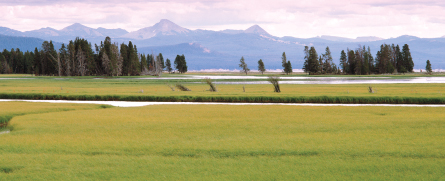
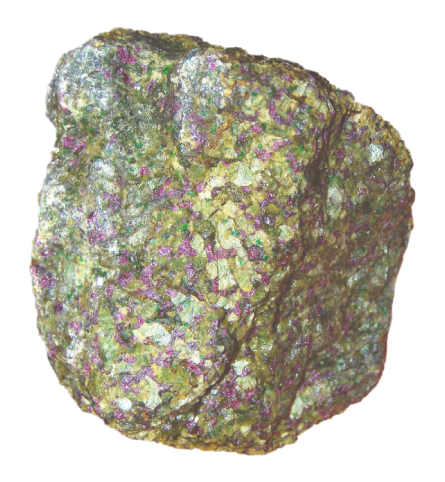
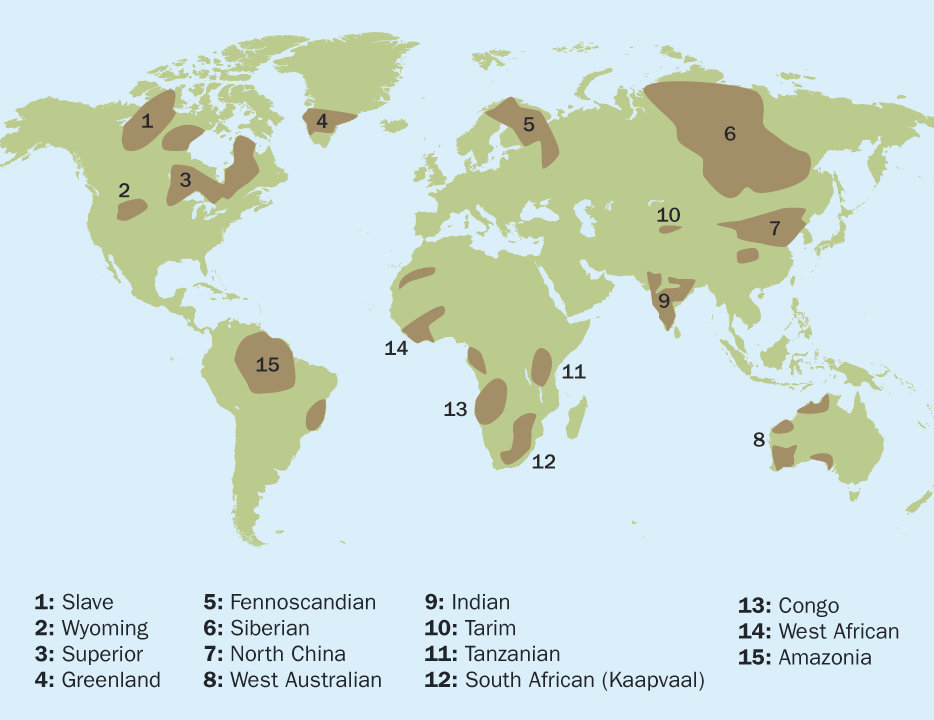
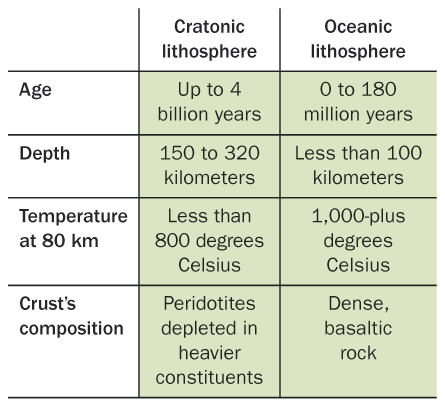
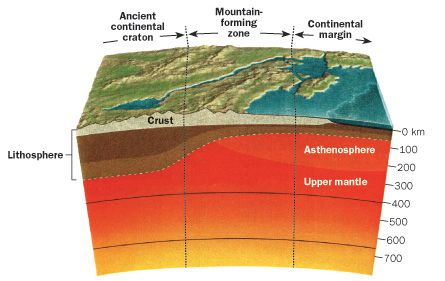
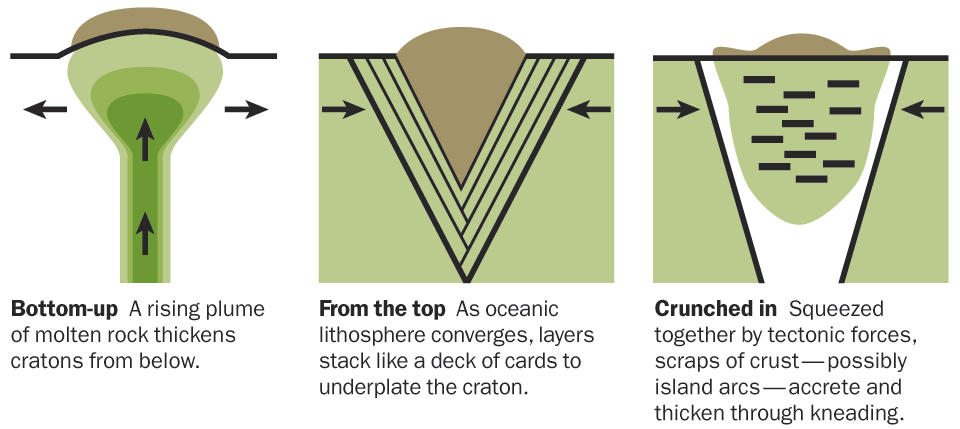
Kober could not know that today, 90 years later, cratons would be objects of intense study. A man of his time, he got little right. He was a fixist and a contractionist. A skeptic of the theory of continental drift first espoused by Alfred Wegener in 1912, Kober believed that the cooling Earth had shrunk just enough over time to explain the folds, mountains and valleys that rumple its crust. He thought ocean floors to be drowned cratons, unyielding and drift-proof, and he laid out his scheme in his influential 1921 book Der Bau der Erde, or “the construction of the Earth.”
The discovery in the 1960s that ocean basins are made of young, spreading crust confirmed Wegener’s basic ideas. Growing continuously from volcanic rifts, the seafloor dives back down when it cools, shrinks and gets dense — pushing continents and the tectonic plates they rest on about like rock scum. Ancient, stable cratons play no part in this underwater action.
But, far from boring, the unyielding hearts of continents to which Kober applied his term hold deep mysteries. Serene and nearly unchanging now, in their youth cratons were places of immense violence and dynamic geological behavior largely impossible on today’s cooler Earth. How exactly cratons formed remains an open question, and geologists continue chipping away at the dogged rocks to try to uncover vital clues to an earlier age.
“Kober was a great field geologist and made great contributions to our understanding of the eastern Alps,” says Turkish geologist Celal Şengör, a top historian of the field who has at least 30,000 early geology books in his home overlooking the Bosporus. But as time went on, says Şengör, Kober got only weirder. “He developed the concept of a mysterious ‘Atomgas’ that welled up from the interior of the Earth and caused magmatism … he was not entirely rational,” Şengör says.
Kober got one thing right: craton. It is an almost perfect word, short and solid as a stone. It derives from kratos, meaning strong and unyielding. Greek myths personified the concept as the minor god Kratos (and the term also inspired the ends of the words democracy and meritocracy, not to mention the relentless warrior antihero of the popular video game God of War).
Cratons started gaining appreciation in the 1970s, when geologists first recognized that the rocks made no outward sense. As solid and cool as they are, cratons should have sunk below the Earth’s surface. A good peg on which to fix the birth of modern craton theory and discovery is the early investigations of one man, Thomas Jordan.
“It became clear to me that cratons were just about the most puzzling things,” says Jordan, of the University of Southern California in Los Angeles. Now 62, he holds an endowed chair in geological sciences at the university, is director of the Southern California Earthquake Center, a member of the National Academy of Sciences, former department chair at MIT, coauthor of a popular geology textbook and winner of many honors.
His role in the field is appropriate. In an odd way, his life history resembles that of a craton: wildly tumultuous youth full of disruption and crisis, followed by a sudden maturity, early adulthood and extended stability.
Jordan was 16 when he graduated from high school in Panama — where his Army-officer father was stationed. But he’d attended a dozen schools and, the eldest of seven kids, had lived in more than 20 houses. With ace scores in mathematics, Jordan went straight to Caltech. But, dazzled and distracted by the freewheeling counterculture of the ’60s, he spent much of his time camping the coast near California’s Big Sur and enjoying the times. “I just plain flunked out,” he says. He planned to quit science.
But a job with a professor running seismometers in the Sierra Nevada above Pasadena made Jordan realize that he could work outside and do physics too. And earth science professors went to bat for him, getting him back into the university. Suddenly, as one of those professors, geophysicist Don Anderson, says, “He got his head on straight. He was worth saving. He was among the most natural born leaders I’d ever seen.”
Jordan finished undergraduate studies and added a Caltech Ph.D. in just three years. Princeton University hired him as an assistant professor at a remarkably young age, 23. There he began developing the isopycnic hypothesis (pronounced like picnic), which attempted to explain cratons’ puzzling qualities. Though some recent discoveries don’t agree with all his forecasts, nearly all papers on the formation and stability of cratons refer to his early studies as seminal.
Isopycnic means equal density. To understand the idea’s importance requires backing up a bit.
Deep enigmas
By the 1970s geologists already knew a good deal about craton surface composition and general size. The continental hearts account for a bit less than half the area of the world’s dry land. Collections of cratons are called shields (or, if covered in thin sediment, platforms). The shield covering most of North America, for example, is an assemblage of smaller units with such names as Slave, Sask, Rae, Churchill and Superior craton. Their bedrock is made of gneiss and other metamorphic rocks whose mineral structures have gotten a long, deep bake in the high temperatures and pressures well underground.
Cratons are flat because erosion has stripped away literally miles of rock, some of it lofty crags. “We are standing among the roots of mountains when we go to the Canadian interior,” Jordan says.
Cratons, like the Greeks’ Kratos, are strong. Beneath the stiff surface lithosphere — the layer of the Earth that includes the crust and the upper part of the mantle and is broken up into tectonic plates — hot elastic rock churns. This slow convective overturning, in a region called the asthenosphere, may swallow whole oceans’ worth of crust but has hardly touched most cratons.
In the 1960s the refraction and alteration of earthquake waves made clear that cratons are deep too. They have roots, or keels, extending at least 160 to perhaps 320 kilometers down and some, including Jordan, say even more than that. Compared with the Earth’s 6,300-kilometer radius, this is like a minor irregularity in an apple peel. But the depth difference is still significant.
Cratons typically are two or three times as thick as oceanic lithosphere. Even mountain ranges such as the Himalayas rest on rock thinner than the low, flat cratons. While the asthenosphere into which the cratonic roots extend may sound like taffy into which a toe is dipped, it is not. “If you picked up a hot piece of the asthenosphere (with thick insulating gloves), it would be harder than steel,” says Norm Sleep, a Stanford University geophysicist. That the cratons have survived through eons has been hard to understand and, to many, still is.
Cratons are cold, a relative term. Go down 240 kilometers in a craton and the rock, while nowhere near molten, is plenty hot — perhaps 1,300° Celsius. But one needs to go down just half as far or less to find rock so hot under the ocean floor (or even where new continental crust is forming in volcanic island chains, or in mountains thrust upward by an ocean plate squeezing its way underneath).
Diamonds pulled from cratons show they are old. The gems form deep in cratons, embedded in rock called peridotite. Fast-moving volcanic eruptions pierce the cratons, dragging pieces of peridotite set with diamonds from the walls of the conduits and belching them, along with ash and residue, across the surface. For decades, geological analysis of decayed radioactive isotopes in the gems and in their host rock has shown that nearly every one in jewelers’ display cases is over 2 billion and sometimes more than 3 billion years old.
The age of the diamonds puts the birth of many cratons during the eon known as the Archean, 2.5 billion years and more ago. Some may go back close to 4 billion years, just half a billion years after the Earth’s birth. The appearance of more cratons seems to have petered out during the Proterozoic eon, which lasted until about 540 million years ago. After that, continents grew by accumulation of new and thinner, more flexible (and mountain-forming) crust.
Such qualities, Jordan saw, added up to a serious conundrum. One simply cannot take standard oceanic lithosphere, make it twice as thick or more, cool it a few hundred degrees, wait a billion or more years and expect it to still be there. Thermal contraction would not only drop its surface below sea level, but the density increase might also sink it altogether into the deep mantle. Even if such a slab of cool crust were to somehow stick around, its extra mass would be detectable with sensitive instruments. No such large gravity anomalies exist.
Jordan hinted at his isopycnic explanation in a 1975 paper in Reviews of Geophysics and Space Physics. In 1978 he followed up with a report in Nature, and elaborated more over the years. He proposed that to be as cold and thick as they are and still sit in the Earth’s outer layers, cratons must be chemically distinct and must have started with a density low enough to compensate for thermal contraction. Such a process could give them an overall density no greater than the crustal average.
He argued that, in the higher temperatures of the Archean, volcanism pulled immense quantities of magma from the deep lithosphere. Up to 30 or 40 percent by volume of a region’s upper mantle rock may have melted and redistributed itself to the surface. The volcanic action preferentially removed aluminum, calcium and iron-rich minerals from the deep, leaving behind a slag of peridotite. A coarse-grained mix of the greenish mineral olivine with a sprinkling of deep purple garnet crystals, peridotites are the most common rock type of the upper mantle. But under cratons, Jordan proposed, the depletion of heavier components through melting left peridotites sharply enriched in lightweight magnesium.
Remarkably, the process not only left the deep rocks lighter than they’d been — and lighter than those in melt-depletion zones still active on today’s Earth — but the erupting lava underwent mineral changes to wind up with less density than its source rock as well.
A final step in Jordan’s hypothesis was to greatly thicken the new, less dense crust. He imagines a process of “advection,” or collisions among cratons as plate tectonics brought them together. Squeezed together by the dynamics of a young, hotter Earth, craton tops would be pushed higher and their feet pushed deeper into the mantle, a process of kneading that would let lighter material preferably move up while denser portions move down. He thus imagines cratons achieving an almost perfect match of density and depth to provide maximum stability.
“I haven’t really changed the idea too much since then,” he says. He still argues that the keels may extend down as much as 350 kilometers or 400 kilometers, for a thick layer that has moved as a unit since the Archean.
Chipping away
But even today great questions remain about how cratons formed. It is not at all clear that the isopycnic hypothesis in full will stand the test of time. For instance, the exact way that cratons got their keels during the distant Archean is still unclear. Three hypotheses have been proposed. One, the surface crust was thickened from directly beneath by a rising plume of semimolten material from far deeper in the Earth. Two, subducting plates of Archean oceanic lithosphere sometimes got lodged beneath cratons, one after the other in an underplating process. And, three, cratons thickened through accretion. In this case, scraps of continental-type crust, possibly island arcs newly formed at sea, could raft against cratons to thicken them or, in Jordan’s view, cratons themselves could squeeze together and thicken.
Recent technological improvements have allowed researchers to better probe deep keels, measuring seismic waves from distant earthquakes. Some resulting papers have favored the arc accretion model of craton thickening. After one survey across Canada’s shield, a team led by Meghan S. Miller, one of Jordan’s colleagues at USC, reported in Geophysical Research Letters detecting boundaries in the keels that suggest that island arcs smashed into cratons, piling up against them over time.
Barbara Romanowicz, director of the University of California, Berkeley Seismological Laboratory, says the patterns she sees in the North American craton also support the arc accretion hypothesis. In Nature in August, Romanowicz and Berkeley postdoc Huaiyu Yuan analyzed seismic shear waves coursing through a North American craton from 94 earthquakes around the world. The pattern of crystal alignment in rock that extends down to about 150 kilometers carries a fossil imprint of a consistent north to south flow. Such a pattern seems to rule out a rising plume, which would probably leave a radial pattern, as the source of the keel’s deeper peridotites.
But the analysis also reveals two distinct layers, a finding that may erode Jordan’s deep keel idea. Beneath the upper layer, a separate layer with a different crystal alignment, creating a distinctly different seismic wave velocity by direction, continues down to between 180 and 240 kilometers. Romanowicz thinks the deeper layer got put in place later than in the Archean — and that only the upper layer, to 150 kilometers down, is from that ancient age.
Still, Jordan’s core insight of highly refractory, high-magnesium rock in the deep hearts of cratons has been consistently verified by studies of rocks dragged to the surface by eons of volcanic eruptions.
A key prediction, that the mineral olivine contained within the peridotite would be unusually dry, got powerful backing in recent studies in southern Africa by a team that included Anne Peslier of NASA’s Johnson Space Center in Houston and David Bell of Arizona State University in Tempe. In the Sept. 2 Nature, the researchers reported testing hundreds of pounds of peridotite that Bell gathered from the waste heaps of diamond mines across southern Africa.
“Most of the rock down there is olivine, and what happens to olivine when it is wetter? It gets much weaker,” Peslier says. But when she and her colleagues calculated how deep the rocks had been for most of the last 3 billion years, they found the deepest to be almost bone-dry. The team calculates that the water content was so low that the rock was 10 times stiffer than typical peridotite. “That is a big reason we still see them, they are so strong,” she said of the cratons’ bottom armor.
Jordan, for his part, is content that his main insight has held up: A vast episode of melting left cratons strong enough, yet light enough, to remain intact and afloat. The details of how they thickened and what that reveals about the early Earth remain to be determined, but researchers are inching forward.
Jordan is no Kober, not stuck in the past nor given to fantasy. But like Kober, Jordan did leave a new term for the field. Isopycnic may not be as elegant as craton, but Jordan’s hypothesis does fill in some of the mystery of these inert continental interiors.
“This very powerful hypothesis allowed me to come up with a view of continents that has been, I think, basically confirmed,” Jordan said recently. “People have been hot for it, and down on it. It is an area where I made a contribution. I hope to see it fully tested by evidence.”